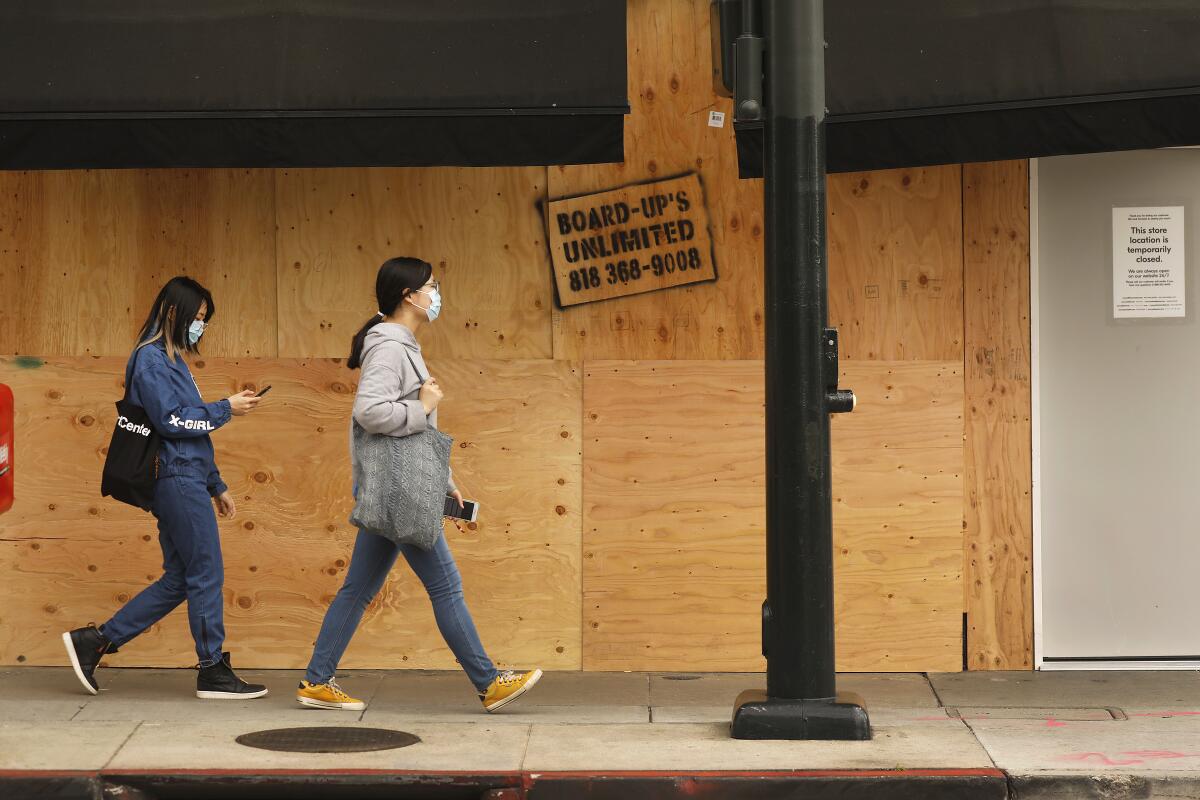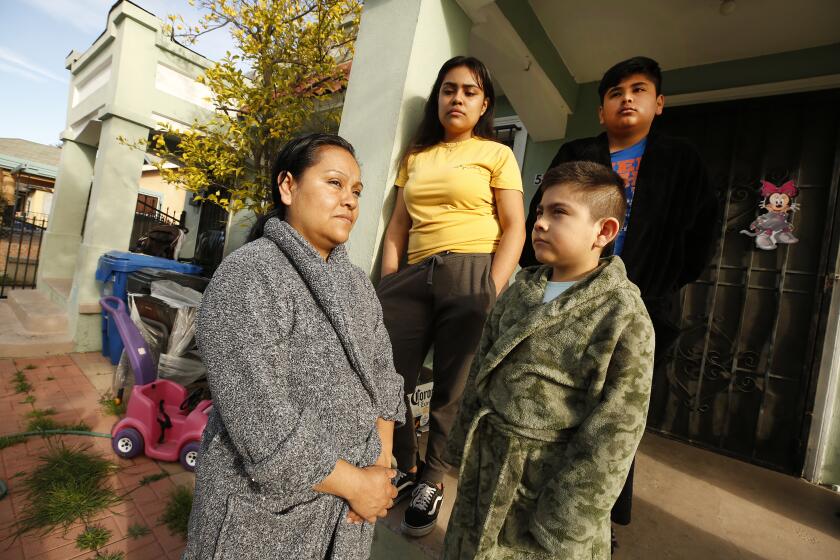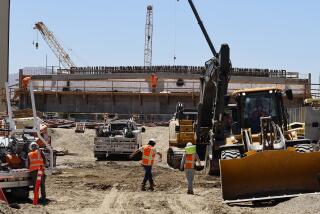Despite gradual reopening, California’s unemployment rate remains stagnant

- Share via
California’s jobless rate ticked down by a tenth of a percentage point in May, with some employers slightly boosting payrolls as businesses gradually reopen across the state.
As the COVID-19 pandemic continued, unemployment edged down to 16.3% from a revised 16.4% rate in April. In Los Angeles County the toll was higher, with more than 1 in 5 workers out of work.
The state’s jobless rate was far above the Great Recession’s peak of 12.3% a decade ago, state officials reported Friday. In May 2019, California unemployment was 4.1%.
Employers added a net 141,600 positions last month, raising the state total to about 15.12 million. But payrolls were down 13% from a year earlier.
In April, a staggering 2.4 million people were thrown out of work, according to an updated estimate from the California Employment Development Department.
“April’s revisions reflect unprecedented job losses never before seen in California’s history in a current data series that dates back to 1976,” the agency said. The layoffs “are a direct result of the impacts of the COVID-19 pandemic,” it added.
Beneath the fury over George Floyd’s death lie longstanding economic inequities that have plagued California’s 2.6 million black people.
The EDD noted in its monthly report that “rapidly evolving data” prompted unusual statistical revisions to its April numbers. (Last month, it reported an April unemployment rate of 15.5%, which was included in an earlier version of this story.)
April’s job loss far eclipsed the record-setting 132,800 jobs erased between December 2008 and January 2009 during the Great Recession.
“California’s job growth engine has come to a screeching halt like an automatic car transmission that suddenly gets thrown into reverse,” said Scott Anderson, chief economist at Bank of the West. “We are forecasting the deepest U.S. and global recession since the Great Depression, and California’s economy will not be spared from the pandemic’s economic and financial damage.”
California’s initial jobless claims have soared by almost 4.7 million since March 21, he added. “This is nearly equivalent to the 4.9 million jobs lost in California during the entire 18-month Great Recession.”
Last week, 240,665 workers in the state filed new applications for unemployment benefits.
Nationwide, May’s payrolls were 11.7% smaller than a year earlier, shedding 17.67 million positions. The U.S. jobless rate fell to 13.3% in May from 14.7% in April, raising hopes that the economy might be starting a slow recovery. However, the U.S. Bureau of Labor Statistics reported that data collection difficulties since the pandemic took hold in March have meant the official jobless rate is understated and may have reached 16.4% in May.
The jobs report, based on two separate surveys of households and businesses, covers the period from mid-April to mid-May.
California’s small gain in May — payrolls grew 0.9%, compared with a 1.9% national rise — may reflect the state’s deliberately slower reopening pace as compared to some other states, said Lynn Reaser, an economist with San Diego’s Point Loma Nazarene University. State and county officials warn there may be a second wave of infections if workplaces open too quickly.
A hotel housekeeper, victim of a coronavirus layoff, struggles to support her three kids. ‘I just want to keep my little family together,’ she says.
“As California’s economy reopens, more people will be recalled to work and new jobs will be created even as others are lost,” Reaser said. “But unemployment will remain disturbingly high as it will take time for the economy to adjust until a vaccine becomes widely available.”
Nine of California’s 11 broad employment sectors gained jobs in May, and two lost positions.
• Construction posted the largest jump (75,000 jobs) thanks in part to low interest rates and strength in specialty trade contractors.
• Leisure and hospitality saw the second-largest gain (64,800 jobs) as some restaurants transitioned to curbside pickup and others opened with social distancing.
• Government had the largest drop (95,800 jobs), with state and local government jobs both experiencing large cuts. School and university closures and slowing tax revenues took a toll.
• The information sector, which includes media and motion picture jobs, lost 6,300 jobs.
The state’s labor force, which includes workers as well as job seekers, shrank in May by 86,000 from a month earlier and by 841,000 from a year earlier. Many laid-off workers weren’t seeking new jobs, possibly because they feared infection or because so many businesses had shut down.
Sung Won Sohn, an economist at Loyola Marymount University, called the labor force contraction “worrisome.” He suggested that the federal government’s generous unemployment benefits, amounting to $600 weekly through July on top of state payments, have encouraged workers to delay returning to the labor market.
“The recovery will be a long process, not an event,” Sohn said. “Hotels, restaurants, airlines and schools will need fewer people. Many small businesses and highly leveraged firms may not survive.”
In Los Angeles County, May unemployment rose to 20.9% from a revised 20.8% in April. Payrolls grew by 33,100 jobs to 3.94 million.
Orange County gained 13,900 jobs last month, bringing payrolls to about 1.4 million. Its unemployment rate rose to 14.5% from 13.8% in April. Joblessness also rose slightly in the Inland Empire, to 14.9% from 14.7%. Riverside and San Bernardino counties gained 17,800 jobs, bringing them to a total of about 1.36 million.
Despite the May uptick in jobs statewide, official notices last month attested to a continuing explosion of layoffs. According to reports filed by employers with 75 or more workers, 3,409 companies erased 406,048 jobs.
That was down from April’s 646,894 reported layoffs. But as a comparison, before the coronavirus outbreak hit the state, just 14,328 layoffs were logged in February under California’s Worker Adjustment and Retraining Notification, or WARN, law, which requires companies to give workers 60 days’ notice of plant closures and mass layoffs.
Much of the COVID-19-related job loss has come at small businesses, but companies with fewer than 75 workers are not required to issue notices. Workers with less than six months of employment, and independent contractors such as Uber and Lyft drivers, are not counted in official tallies.
In the first half of June, even as some businesses started to reopen and rehire furloughed workers, official WARN layoff tallies reflected a historic pace, with 1,538 companies shedding 129,298 employees.
Hotels, restaurant chains, entertainment venues and travel-related businesses, the hardest hit in the early stage of shutdowns, continued to furlough staff last month. Enterprise Rent-A-Car laid off more than 1,000 workers statewide. More than 700 people lost jobs at San Manuel Casino in San Bernardino County. Loews Hotels in Santa Monica and Hollywood shed more than 500 workers. And the Segerstrom Center for the Arts in Orange County laid off about 515.
Layoffs have spread across many sectors. In retail, Gap, which had been struggling before the pandemic, announced it would lay off 10% of its corporate staff, including 264 in San Francisco. The company closed most of its 3,300 stores, furloughing 80,000 retail workers nationwide, in March.
Stitch Fix, also based in San Francisco, notified 1,400 California-based stylists they would be laid off as the company sought to cut costs by relocating to lower-wage states such as Texas and Ohio.
Manufacturers were hit too, with GKN Aerospace Transparency Systems in Garden Grove laying off 40 workers and Cambro Manufacturing, which fabricates restaurant equipment in Huntington Beach, shedding 150 workers.
The Los Angeles Museum of Natural History furloughed 121 employees. Altamed Health Services, which operates medical clinics, laid off 136 in Los Angeles as coronavirus-fearing patients avoided venturing out to visit doctors and dentists.
Some workers may be rehired this month and in coming weeks, but with social distancing requirements and a recession squeezing pocketbooks, an untold number of temporary layoffs may become permanent.
Unemployment rates fell in May in 38 states and the District of Columbia, rose in three states and stayed stable in nine states, federal officials reported. Payrolls grew in 46 states, decreased in Hawaii and the District of Columbia, and were unchanged in three states.
More to Read
Inside the business of entertainment
The Wide Shot brings you news, analysis and insights on everything from streaming wars to production — and what it all means for the future.
You may occasionally receive promotional content from the Los Angeles Times.













